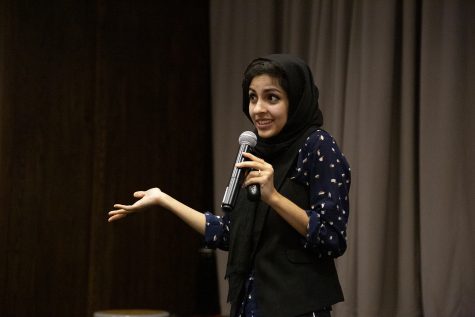Hoda Katebi talks Iranian fashion, politics and imperialism with Columbia students
September 19, 2019

Hoda Katebi, a famous Iranian fashion blogger, talks to Columbia students about Eastern fashion influences and rejecting cultural limits in style, held at 618 S. Michigan Ave. on Sept. 12.
A Chicago-based author, activist and fashion blogger, whose profile was raised by a notorious WGN-TV interview, delivered a blunt message to Columbia students on Iranian fashion, racism and voicelessness—”the biggest bulls–t term that has ever existed.”
During the Sept. 12 discussion, held at 618 S. Michigan Ave., Hoda Katebi, a University of Chicago alumna, used humor, history and personal experience to navigate topics including Western influence on Iranian fashion, racism and corporate activism.
“I want you to jump in, engage, interrupt me at any moment, be participatory as much as you can,” Katebi told the audience. “Unless you’re a white man. I prefer that you raise your hand because you’ve interrupted us enough.”
Author of the photographic book “Tehran Streetstyle” and co-founder of Chicago-based fashion co-operative Blue Tin, Katebi went viral following a WGN-TV interview where she was asked about nuclear weapons and was told she didn’t “sound like an American” by anchor Robin Baumgarten. “That’s because I’ve read,” Katebi responded.
Melissa Gamble, assistant professor in the Fashion Studies Department, said she invited Katebi to speak after partnering with her and witnessing the “groundbreaking work” she does to empower women and people of color.
“Hoda came to mind as someone that would be a fantastic voice to bring to campus for students to hear about her journey, about the work that she’s doing and her perspective on fashion and how fashion intersects with politics [and] feminism,” Gamble said.
During the discussion, Katebi gave a brief lesson on Iran’s roots with gender fluidity in fashion. These ideas were quickly replaced in Iran with British imperialist influences of strict, gender-binary clothing and heteronormative practices, she said.
“Iran now being more queer-positive [and having] a lot of fashion embracing gender ambiguity is seen as a Western step toward progress,” Katebi said. “What is it actually? … It’s a step toward Iran’s own history.”
Katebi said this stems from orientalism, a Western ideology that perceives Eastern people as having less agency and voice.
“This lens is another form of violence, in which the closer you are dressed to a Muslim subject—Eastern—you’re seen as backwards, you’re seen as uncivilized, barbaric, oppressed and the more you are dressed to a Western subject, you’re free, you’re liberated,” Katebi said.
Oula Yassine, president of Columbia’s Muslim Student Association and senior fashion studies major, said Katebi is an inspiration to her and many other girls by the way she responds to hate and stands her ground.
“She is the type of influence we need in the world because, growing up, I feel like we didn’t have proper representation within the Muslim community,” Yassine said. “She’s rising and she’s giving Muslims a good name, and she’s showing people who we are.”
Yassine said many people from America, specifically feminists, do not understand the culture they are criticizing, or why Muslim women wear a hijab.
“Take for instance, ‘Free the hijab,’” Yassine said. “I feel like a lot [of] Western feminists—they think that we are oppressed because we wear the hijab. And it’s something they need to have more education [on].”
“Personally for me wearing a hijab makes me feel empowered,” Yassine said. “I feel more comfortable wearing the hijab than I do without. I love all aspects of fashion and I love to dress up and I feel [like] the hijab is never a burden.”
Gamble said looking at fashion from a multicultural perspective is essential to understanding how the industry can be more inclusive to underrepresented populations.
“The industry is not yet recognizing … the level at which they need to open the doors and bring in designers of color [and] stylists of color from all cultural groups,” Gamble said
Katebi warned that displays of diversity are not the same as real systematic change, as many companies claim to support Muslim women, yet do nothing while Muslim women suffer horrible conditions in their sweatshops.
Reports by the Huffington Post and Global Labor Justice claim women workers in the garment factories of major brands face severe financial instability and gender-based violence.
“Representation doesn’t always equal liberation,” Katebi said. “I think in the fashion industry we oftentimes get those two confused. … It’s useless to use people of color’s faces if those voices are not actually coming with them and substantial changes are not being made.”







